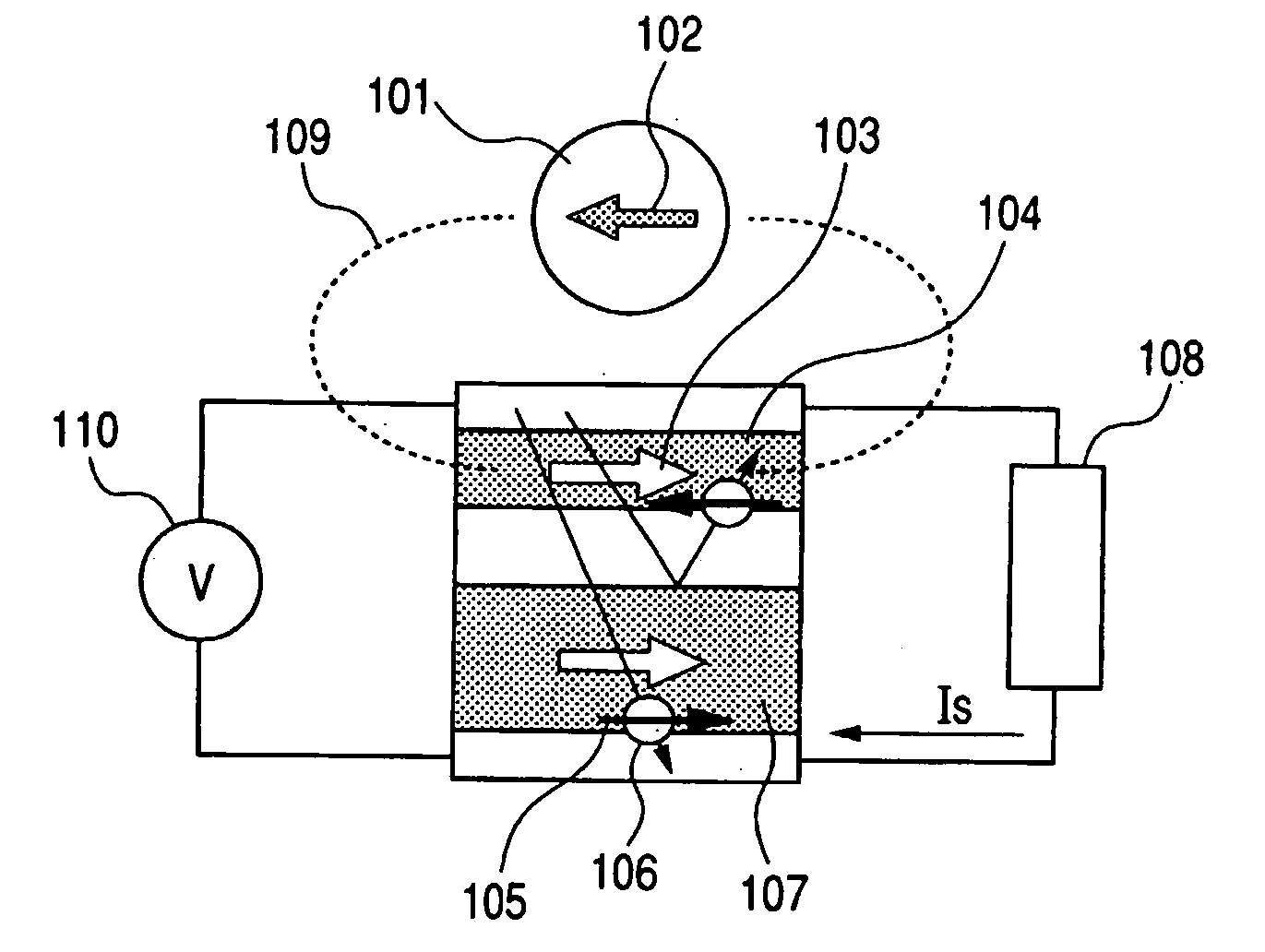Magnetic Material Sensor and Detection Method Employing this Sensor, and Target Material Detection Sensor and Target Material Detection Kit
a technology of magnetic material and detection method, which is applied in the direction of magnetic beads labelled molecules, magnetic property measurements, instruments, etc., can solve the problems of inability to detect magnetic particles, and inability to invert the magnetization direction. achieve the effect of compact production
- Summary
- Abstract
- Description
- Claims
- Application Information
AI Technical Summary
Benefits of technology
Problems solved by technology
Method used
Image
Examples
first embodiment
[0055]FIG. 5 is a conceptual diagram showing the structure of a magnetoresistive effect film used for the magnetic material sensor of the present invention, and the positional relationship of the film and a magnetic particle. A TMR film is employed as a magnetoresistive effect film, and a Al2O3 film is employed as a spin tunnel film 504. Further, an artificial antiferromagnetic film is deposited under the Al2O3 film and is used as a magnetized pinned layer. The magnetized pinned layer is provided by overlaying, on an lower electrode 501, a MnIr film 502 and a laminated film 503 consisting of a FeCo film, a Ru film and a FeCo film. Since the two FeCo films are magnetically coupled, and the magnetization directions are constantly antiparallel, magnetostatic coupling between the magnetized pinned layer and a detection layer or a magnetic material to be detected is weak. On the Al2O3 film, an exchange coupling film consisting of a FeCo film 505 and a NiFe film 506 is deposited and is us...
second embodiment
[0060]In the first embodiment, the rectangular TMR film that employs in-plane magnetized films has been used as a magnetic material sensor. However, the magnetic material sensor of this invention can be provided by employing perpendicular magnetized films.
[0061]In a second embodiment, an example for detecting small magnetic particles having a particle size of 50 nm will be explained. As in the first embodiment, a magnetic particle to be detected is coupled with the SH group, and a Au film is formed on the top of a magnetoresistive effect film. The circuit of a magnetic material sensor is the same as that in the first embodiment and the magnetoresistive effect film is a TMR film that, as shown in FIG. 7, is formed by laminating a TbFeCo alloy film, a FeCo alloy film, a Al2O3 film, a GdFeCo Alloy film and a Pt film in the named order. The TbFeCo alloy film is a perpendicular magnetized film having a composition that is superior in magnetization to the auxiliary lattice of a transition...
third embodiment
[0065]The magnetic material sensor of this invention can also be employed as a biosensor. In a third embodiment, an explanation will be given for a biosensor that detects a prostate specific antigen (PSA) that is known as a marker for prostate cancer.
[0066]A magnetoresistive effect film used for this embodiment has the same structure as the TMR film used for the first embodiment, and the particle size of a magnetic particle is about 100 nm.
[0067]In order to hold the primary antibody on the surface of an Au film that is deposited on the magnetoresistive effect film, the surface of the Au film is treated with a piranha solution (sulfuric acid:hydrogen peroxide=3:1), and is thereafter treated with a 1 mM ethanol solution of 10-carboxy-1-decanthiol. As a result, a self-organizing film (SAM) wherein a carboxyl group is represented is deposited on the surface. Furthermore, in order to immobilize the primary antibody, a soluble carbodiimide (WSC) and a N-hydroxysuccinimide react with each ...
PUM
 Login to View More
Login to View More Abstract
Description
Claims
Application Information
 Login to View More
Login to View More - R&D
- Intellectual Property
- Life Sciences
- Materials
- Tech Scout
- Unparalleled Data Quality
- Higher Quality Content
- 60% Fewer Hallucinations
Browse by: Latest US Patents, China's latest patents, Technical Efficacy Thesaurus, Application Domain, Technology Topic, Popular Technical Reports.
© 2025 PatSnap. All rights reserved.Legal|Privacy policy|Modern Slavery Act Transparency Statement|Sitemap|About US| Contact US: help@patsnap.com



